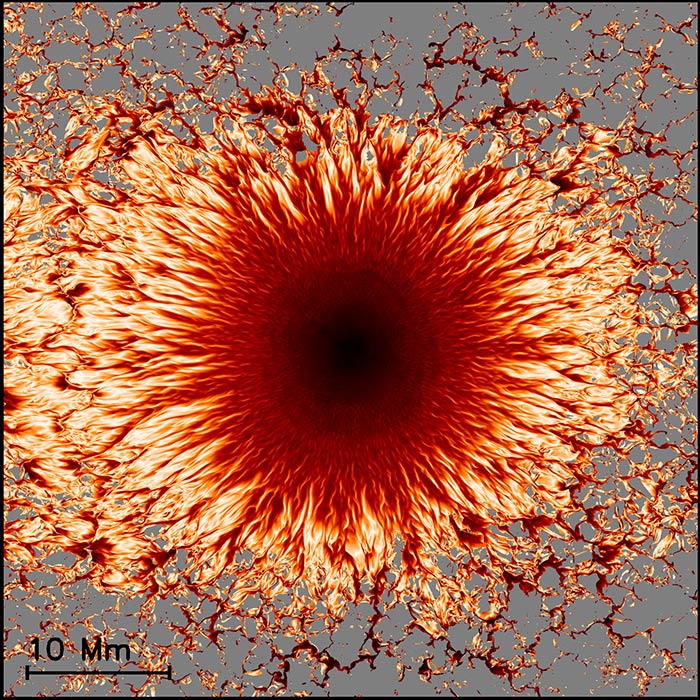Sunspot
Dec 16, 2009
This image is from a computer model of a sunspot. Notice the scale bar at the bottom--that's not millimeters but Megameters: 1 Megameter = 1,000 kilometers.
Sunspots are occasionally visible to the naked eye near sunrise or sunset, if they are particularly large and if there's haze or thin clouds to partially dim the sunlight. Since the middle of the nineteenth century, it's been known that they have something to do with the sun's magnetic field, and that they may have consequences for electrical activity here on earth. We know that sunspots come and go in cycles lasting about eleven years and that years of high sunspot activity are often characterized by relatively cold weather. But even today, people who know a whole lot about sunspots say they don't understand them all that well.
The complex interaction of magnetic forces, superheated gases, the sun's huge gravitational field, and the nuclear reactions that keep stars glowing can't all be modeled in detail on a Macbook. In fact, supercomputing power has only recently become available in support of such a project, and this simulation of sunspot activity--published last June by researchers from the National Center for Atmospheric Research in Boulder, Colorado, and the Max Planck Institute in Germany--is said to be the first comprehensive model. The sunspot itself is represented by the dark spot in the middle; it's a sort of blob of solar gas that no longer glows white-hot like the rest of the sun because it's been ejected from the main solar body by a fierce magnetic storm. Once it's ejected, the gas is not part of the ongoing nuclear reaction heating the sun.The blob cools down a bit and shows up dark compared to the glowing disk of the sun, though it's still plenty hot. It doesn't fly off into space because the sun's gravity keeps it trapped, but it can't reconsolidate into the main solar body because of magnetic forces. All these processes and more are computer-modeled to produce a sort of movie in which a sunspot is born, grows, and eventually dies. The colors of the imagery reflect the relative heat of the gases.
The authors of this model admit it is flawed; the gas flares near the edges of the penumbra are sized incorrectly. They say they know how to fix this issue but do not yet have the super-supercomputing power they would need to do the job right.
Sunspot activity is correlated with cold weather on earth because the blobs of dark, relatively cool gases block a bit of the sun's heat from radiating out to the earth. The years 2009 and 2010 are fairly high sunspot years in the eleven-year cycle, so we shouldn't be surprised if this winter winds up relatively cold--not abnormally crazy cold, but perhaps on the cold side of average. The sunspot effect may become less noticeable, however, as global warming progresses; even if we collect a little less heat than average from the sun this year, relatively more of that heat will be trapped in our atmosphere by greenhouse gases, and relatively more of this year's heat will still be trapped in our atmosphere next year and the year after that. Each year, the trapped heat is becoming relatively more important in controlling our weather, and small fluctuations in heat input caused by sunspots are becoming relatively less important.
The magnetic storms associated with sunspot activity, however, remain extremely important. Disruptions in the sun's magnetic field can wreak havoc with sensitive electrical equipment here on earth, even causing major blackouts in the electrical grid. It has been suggested that if we understood sunspots better we might eventually learn to predict them.
